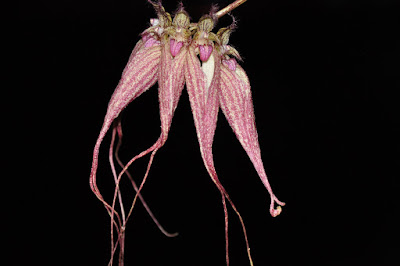Bulbophyllum ornatissimum is native to Northeast India. These orchids are found in Sikkim in the Darjeeling region and in Meghalaya. They grow there on the bushes near streams, in the tropical region, at heights of 500-600 m.
Bulbophyllum ornatissimum, also called as The Ornate Bulbophyllum, Cirrhopetalum ornatissimum, Mastigion ornatissimum, Phyllorchis ornatissimum, is a species of the genus Bulbophyllum. This species was described by Johannes Jacobus Smith in 1912.
IDENTIFY BULBOPHYLLUM ORNATISSIMUM
Bulbophyllum ornatissimum is native to Northeast India. These orchids are found in Sikkim in the Darjeeling region and in Meghalaya. They grow there on the bushes near streams, in the tropical region, at heights of 500-600 m.
It is a small sized, warm to hot growing epiphyte, which can reach a height of 7.5-12.5 cm, with 2.5 cm long ovoid pseudobulbs and a single, apical, linear-oblong, obtuse, 5-10 cm long and 1.8-2.2 cm wide leaf with no tail grows at the top of each pseudobulb.
The Ornate Bulbophyllum carries 3 to 5, apical, fragrant flowers in an umbel on each erect, 6" (15 cm) long inflorescence which arise from the base of the mature pseudobulb occuring in the fall. The flowers are 11.5-18.5 cm long, measuring from the top of the dorsal petal to the end of the lateral outer petals. The petals of both whorls are yellow with red stripes or veins. The lip has a variable color, from purple to purple-red. The upper sepals are lanceolate, with cilia along the edges and a sharp, slightly curved tip. The lateral sepals are long and narrow, almost along the entire length connected to each other and only their filiform tips are separate and twisted. On the tops of small narrow triangular petals there are bunches of drooping villi.
BULBOPHYLLUM ORNATISSIMUM CARE AND CULTURE
Cultural information should only be used as a guide, and should be to be adapted to suit you. Your physical location; where you grow your plants, how much time you have to devote to their care, and many other factors, will need to be taken into account. Only then can you decide on the cultural methods that best suit you and your plants.
Light:
Bulbophyllum ornatissimum needs a light level of 15000-25000 lux. The southern sun can burn plants, but they require a fairly high level of filtered or scattered light. Strong air movement should be ensured all the time.
Temperature:
The average temperature of the summer day is 30 ° C, the night 23-24 ° C, and the daily difference is 6-7 ° C. The average temperature of the winter day is 21-23 ° C, the night 9-12 ° C, and the daily difference is 11-12 ° C.
Humidity:
This plant needs a humidity level of 80-85% in the summer and early autumn. Then, at the end of autumn and at the beginning of winter, it drops to 75% and continues this decline up to 50% at the beginning of spring.
Substrate, growing media:
Bulbophyllum ornatissimum is best to be mounted on a cork or tree fern root provided high humidity is ensured and watering is carried out at least once a day in summer. When the weather is hot and dry, you may need to water several times a day.
They can also grown in containers, it should be baskets or flat containers such as those used to plant bulbs or azaleas. When growing in pots, the lower half of the pot should be filled with very good drainage, eg thick or medium sized pieces of bark or cork. The top half of the pot should be filled with a fine substrate, eg a bark, cut with ferns of tree ferns, which retains moisture, but not a waterlog. Usually, additives such as perlite, peat moss cut as well as charcoal are used, which relaxes the substrate and prevents it from souring. A mixture containing tree fern is recommended because it does not decompose as quickly as the bark, and this results in less frequent repotting.
Repotting:
Bulbophyllum ornatissimum react badly to root disturbance, and sometimes even for a year or more, they get rid of division or repotting. If the substrate is not spread and the plant has grown out of the container, the whole plant should be repotted, including the root ball, into a larger container without disturbing the root system. If the substrate is spread and, however, repotting is necessary, it should be done when new roots begin to grow, because then the plant will stabilize in the shortest possible time.
Watering:
The Ornate Bulbophyllum should be abundantly watered during active growth, but excellent drainage should be ensured, and the ground around the roots can never be desiccated or soggy. When new growths reach maturity in autumn, the amount of water should be reduced.
Fertilizer:
During growth period, it is recommended to feed the plants 1/4-1/2 weekly fertilizer doses for orchids weekly. You can constantly use a balanced fertilizer, and you can use a fertilizer with a high nitrogen content from spring to mid-summer, and then until the end of autumn - with a high content of phosphorus.
Rest period:
In winter, Bulbophyllum ornatissimum need less water and should dry out slightly between waterings, but they can never remain dry for too long. When the amount of water decreases, the amount of fertilizer should also be reduced.















COMMENTS